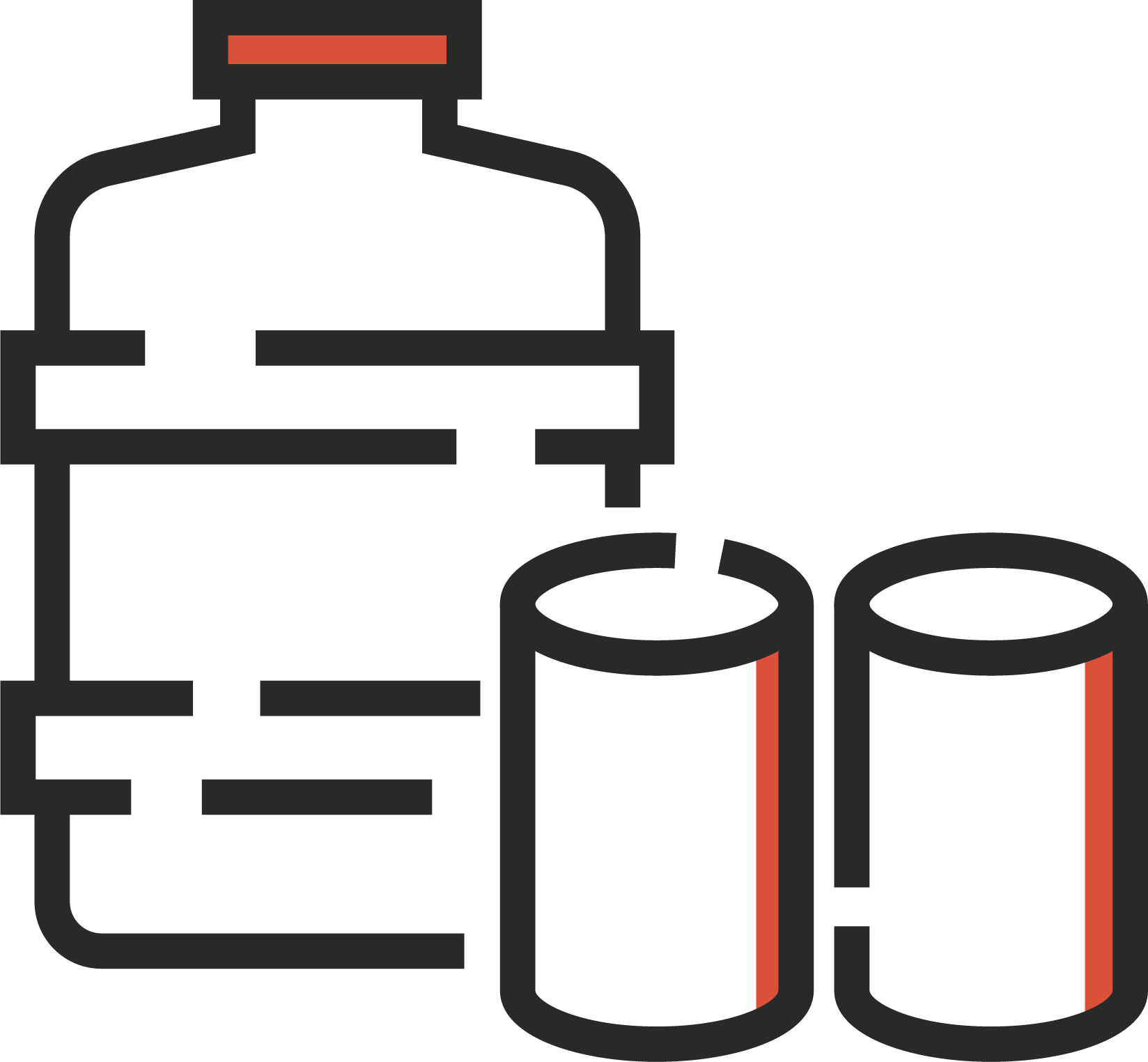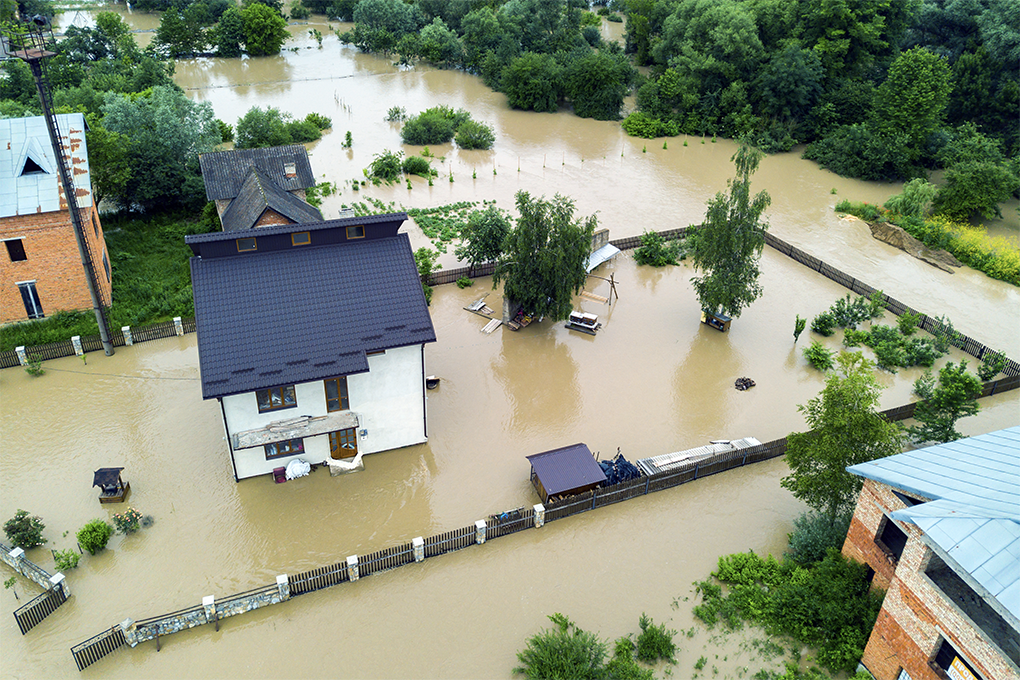NASA is predicting that this winter and spring season will likely see much higher instances of flooding, and more severe floods, than in previous years. 2023 alone saw 28 severe weather events, many of which resulted in extreme flooding, with damages costing $92.9 billion.
You might think that you’re not at risk of a flood, but the reality is that since the year 2000, nearly 300 days of each year saw a significant flood, with all 50 states seeing floods in 2021, landlocked or not.
It’s projected that by the year 2053, 20.8 million properties in the USA will have an 80% or higher chance of flooding, while the typical price to restore water damage in a home in the USA is up to $5,954.
With extreme weather events happening more often, and the rising cost of living, it only makes sense to protect your home from floods and water damage.
One of the best ways to do this is with a flood barrier. Flood barriers for doors and garages are your front line of defense, but how do you choose one? Let’s determine how to choose the best flood barrier, and then take a look at some of the best options that the market has to offer.
Contents
- Key Takeaways
- Understanding the Threat: How Floods Can Damage Your Property
- The Evolution of Flood Protection: Beyond Sandbags
- Types of Flood Barriers for Doors
- Best Flood Barriers for Doors
- GaraDry Flood Barrier
- AmyLove Inflatable Flood Barriers
- Garage Door Flood Barrier Kit
- Fdit Deluxe Flood Barriers
- Quick Dam Water Activated Flood Barrier
- Key Features to Look for in a Flood Barrier
- Installation and Maintenance Tips
- Making the Right Choice for Your Home or Business
- Conclusion
- Flood Barriers for Doors: Frequently Asked Questions
Key Takeaways
- Floods can cause untold damage to homes and businesses alike, with $2.8 billion of flood damage having occurred to property in 2022 alone.
- As severe weather events are becoming more frequent, the need to protect your home and business from flooding has never been greater.
- There are many types of flood barriers, each with its own features and benefits, and selecting the right one for your situation can make the difference between staying dry and standing knee-deep in a pool of floodwater.
Understanding the Threat: How Floods Can Damage Your Property
Floods are more than just a little bit of water running into your home. In fact, as you can glean from the statistics we’ve provided above, floods pose a very serious threat to your property and belongings.
Water Damage In the Home
For instance, one of the leading issues associated with flooding is structural damage. Water can weaken foundations, cause damage to walls, and lead to more serious issues that may compromise the overall structural integrity of the home, especially where your basement is involved.
The effects can reverberate beyond structural damage, as flooding can also ruin all of your furniture and appliances. Anything made with upholstery, wood, or electrical components will surely be ruined by a flood of water. But they can also be quite dangerous if there are live wires exposed during a flood. Not only can that be costly, but it can pose a threat to your well-being.
Once the water has drained back out of your home, you might think that you’re in the clear, but moisture often sticks around for quite some time.
This can result in mildew and mold growth throughout a home, posing serious health risks. Although, mold and mildew risks can be mitigated with the right kind of dehumidifier.
What’s more, stormwater can be contaminated with sewage, chemicals, and other substances that may be harmful to your health.
Water Damage to Your Business
If a flood affects your business, it produces a whole different set of problems as far as maintaining a stable income is concerned. In fact, flooding is the most frequent and costly natural disaster in the USA.
If your home floods, you can still go to work, earn an income, and repair your home as needed. However, as far as a business is concerned, that’s your livelihood, and if a severe flood causes property or equipment damage, it might just cost you your business.
Restoration and repair, submerged and broken machinery, ruined stock and goods, and time required to get the business operational again can all cost substantial amounts of money. At the very least, you’ll have to deal with a loss of revenue, and worst-case scenario, your business might end up going under. According to official statistics, up to 25% of small businesses in the USA that are affected by natural disasters never recover.
To help prevent your home or business from being damaged, possibly irreversibly, one of your first lines of defense is the flood barrier. However, if you aren’t familiar with flood barriers, you might not know what you’re looking for, and that’s what we’re here to help with right now.
The Evolution of Flood Protection: Beyond Sandbags
For hundreds of years, the number one way to protect homes and properties from floods was by using sandbags. These are bags made out of cloth or plastic, filled with sand, which are then piled side by side and on top of each other, effectively forming a wall or dam to keep water at bay.
They are low-cost and generally quite effective for mild and moderate flooding situations, but they have drawbacks. Sandbags require a lot of labor to set up, they cause disposal issues, and they’re not always guaranteed to be watertight. In some cases, severe floods may render sandbags useless.
This is why modern flood defense systems have evolved over the years. Technology is seeing a shift towards much better materials that are more able to withstand the ferocity of floods, combined with more effective methods of blocking water from getting into a home or business.
Home protection experts have developed a variety of flood defense barrier types, all of which have their pros and cons. That said, sandbags are still a tried and true method for flood protection, and if it’s something you’d like to take advantage of, check out these best sandbags for flooding.
Types of Flood Barriers for Doors
There are a wide variety of flood barrier types for doors, each of which has its own specific uses and advantages, so let’s take a quick look.
Garage and Large Span Door Dams
This is a type of flood barrier that is specially designed to protect large entrances from being flooded, such as garage door openings. They’re usually made out of some kind of reinforced plastic or strong metal and are sometimes designed to be permanent.
These water dams are usually adjustable for width, to accommodate various sizes of garages and other wide openings.
There are also both manual models as well as those that deploy automatically. If you have a low-lying garage, barn, or any other such building that is at risk of being flooded, it is a large-span door dam that you require.
Inflatable Seal Flood Barriers
Next, we have the inflatable seal flood barrier. These use either water pressure or air pressure to inflate and seal off doorways and other openings. What’s ideal about these is that they are extremely lightweight, small, and portable.
They are also ideal for emergencies, as they can be deployed very quickly, which is ideal for both commercial and residential purposes when time is of the essence.
What’s also ideal about inflatable door barriers is that they come in many different sizes, therefore allowing you to choose the one that works best for the opening in question. They’re also convenient because once a flood has passed, you can just deflate them, roll them up, and put them away for the next flood emergency.
Flood Shields for Standard Door Openings
Flood shields are generally designed for standard door openings. These are barriers that are made out of reinforced plastic, steel, aluminum, or any other durable material. They are designed to create a 100% water-tight seal in any doorway.
You can think of these more or less as solid walls that block a whole doorway. Some may only reach partially up a doorway, whereas others may cover full doors, from bottom to top.
These are also ideal for emergencies, as they can usually be deployed very quickly and attached to doorways without the use of any tools. They often consist of permanent frames affixed to the door or garage frame, into which wall sections can be inserted and removed as needed.
Window Flood Barriers
Finally, we have the window flood barrier. These are very similar to flood shields for doors, besides the fact that they’re designed specifically for Windows. They’re usually made out of something like polycarbonate or other durable materials, such as metals. Some are temporary and easy to deploy, whereas others may be permanent. These can often be customized to fit specific sizes and types of windows.
Best Flood Barriers for Doors
Now that you know what the different types of flood barriers are, let’s take a look at the five top options available on the market.
GaraDry Flood Barrier
Here we have an extremely simple flood barrier, a large-span barrier designed for wide openings such as garages. Made of heavy-duty PVC and being 2” high makes it perfect for keeping water out of your garage. The 16’ model comes in at just over $1,500, which is on the higher end, but you get what you pay for, and this unit is built to last.
Main Features
It comes in at 16’3” long, which means that it should be more than wide enough for most standard garages.
It’s not adjustable in size, so if your garage door opening is smaller, you’ll have to cut this unit down to size.
It is 2” high, which should be more than high enough to handle most standard flooding situations, particularly those caused by heavy rains.
It comes with an easy-to-install do-it-yourself kit, along with the adhesive required to attach it to the ground. This is a permanent solution, making it ideal for areas that are highly prone to flooding.
The flood barrier itself is made out of superior heavy-duty PVC, so it won’t degrade with prolonged water contact, and it works well in all sorts of temperature situations too.
Pros
- Impact and weather-resistant
- Easy DIY job
- Long enough for most garages
- 2” height should suffice in many cases
Cons
- Adhesive may come undone over time
AmyLove Inflatable Flood Barriers
Moving on to a different type of flood barrier, here we have inflatable flood barriers designed for ease of use and portability. These don’t really fall into any one category, as they are inflatable multi-purpose flood barriers that can keep water from moving up your driveway, keep it out of your yard, and stop water from penetrating your garages, barns, and home doors alike. It’s certainly one of the more affordable options, coming in at under $100.
Main Features
Although they are inflatable, you don’t fill them with air, but rather with water. Filling them with water ensures that they are heavy enough to stay in one place and to resist large amounts of water moving against them.
Each package comes with four units, 6’ long and 6” high. This size should be ideal for most standard doorways, although there are also other options available.
There is a 12’ option, and even a 24’ option, which is 12” high. Whether you need a short and low barrier for small doorways or a very long and tall barrier for large openings such as garages, here you should find at least one size that works for you.
They are made out of PVC, so they are quite resistant to the elements, as well as to puncturing. With that being said, because they are inflatable, they are not quite as resilient as solid flood barriers, although the big advantage here is that they are portable.
You can quickly fill them with water, and once you don’t need them anymore, just drain them, roll them up, and put them away.
Pros
- Durable enough for most situations
- Being inflatable also allows for relatively fast deployment.
- Portable and easy to store
- Ideal for most standard doorways
- 6” height + several size options available
Cons
- Cannot be physically secured to a doorway
Garage Door Flood Barrier Kit
Next, we have this garage door flood barrier kit, a standard flood shield for a doorway consisting of a frame permanently attached to the doorway, with aluminum slats that can slide in and out, allowing you to create a barrier as low or high as needed. The frame stays in place, so you can insert the aluminum slats at a moment’s notice, allowing for quick deployment. It’s a super durable unit, and for just under $500, is more than reasonably priced.
Main Features
The shield itself is made out of extremely durable aluminum alloy, which is resistant to rusting, impacts, warping, water damage, and more. It’s one of the most durable flood barriers that you can get your hands on.
This is an ideal option for those who are worried about multiple floods. It has a frame that you attach to a doorway, which horizontal metal panels slide into. The horizontal metal panels have special grooves so they fit snuggly with each other, and also feature a compression seal using a simple latch system.
The bottom also features a special rubber stopper. Although the frame stays attached to the door, when there is no risk of flooding, the horizontal panels can be removed, so you can use the doorway regularly.
The frame may take a bit of work to install properly, but once it is installed, the metal panels are very fast and easy to insert and remove. As long as you have the frame installed beforehand, this unit is very quick to deploy in the event of an emergency.
Although this is an expensive option, one thing that stands out is that the size is customizable, which means that you can get one for any size doorway, garage opening, or anything in between. It even comes with special reinforcement legs that brace the flood shield from behind, therefore allowing it to resist greater amounts of water pressure.
Pros
- Secure and reliable
- Very damage resistant
- Ideal for permanent use
- Reinforcement legs for added stability
- Easy to install
Cons
- Requires permanent installation – alteration of doorways
Fdit Deluxe Flood Barriers
While new technologies are effective at keeping flooding at bay, good old-fashioned sandbags still work just fine. Here we have the new and improved sandbag, one made of super-strong fibers complete with a waterproof lining. They’re ideal for stacking in driveways and doorways alike, and have the ability to hold back significant amounts of water. Here you get 10 pieces for just over $20, which in the grand scheme of things is quite cost-effective.
Main Features
What we have here are sandbags made with 600D polyester material, which means that they are durable, sturdy, and even reusable.
For those who might not know, the “D” stands for Denier, a unit of measurement that defines the thickness and weight of the fibers used. As for the “600”, this is on the higher end of the spectrum, as 1000D is the highest that polyester usually goes, and that is quite rare. 600D polyester is generally considered to be heavy-duty and suitable for outdoor use.
You can fill and empty them multiple times without having to worry about them breaking. A special watertight inner lining also makes them waterproof, especially when full of sand.
The big advantage here of course is that sand is also quite heavy, which helps to resist great amounts of water pressure. They feature an easy drawstring closure, so you can easily fill and empty them as needed. Each package comes with a total of 10 units.
Pros
- Simple yet effective
- Durable
- Reusable
- Affordable
Cons
- Slow to deploy
Quick Dam Water Activated Flood Barrier
This is an interesting type of flood barrier that activates automatically once it gets wet. It’s almost like a massive baby diaper that absorbs any liquid in its path, becomes heavier and stabler as it absorbs liquid, and works as a rapid deployment option for fast-incoming storms. $40 for a self-inflating flood barrier isn’t overly high, and it looks even more cost-effective when you consider that it’s reusable.
Main Features
The Quick Dam comes as a small package, but once it gets wet, it begins to absorb water and grow. Once it gets wet, it only takes just a few minutes for it to grow to full size. There is an absorbent material on the inside, a polymer that is similar to what is found inside of baby diapers, which turns into a heavy and stable gel once it gets wet.
It’s good for basic use and for diverting water, but keep in mind that it still takes some time to grow to size, so if there is a large surge or wave of water incoming, it may not act quickly enough for you to reap the full benefits. Therefore, it’s best used for situations where floods may occur due to slowly rising waters, such as due to a heavy rain storm.
Each unit can grow to 10’ in length and 3.5” high, therefore making it ideal to block large openings such as garages, as well as to stop water from traveling up driveways and other such areas. This is a product best used for outdoor purposes.
Pros
- Automatic activation
- Ideal for basic water diversion
- Works well for outdoor use
- Simple to use
- Durable build
Cons
- Activation process is somewhat slow
Key Features to Look for in a Flood Barrier
Before you go out and choose any flood barrier, there are some key factors that you want to look out for.
Quick and Easy Installation
One of the most important factors in flood response is quick and easy installation. This is especially the case if you’re dealing with an emergency where time is of the essence. You don’t want to be fumbling with installing a flood barrier when the water is rushing at you.
If you think that you need a permanent flood barrier, especially if you live in an area that is prone to flooding regularly, use something like a door shield where the barrier is permanently affixed to the frame of your door or garage. The frame stays in place, and the main part of the barrier can be quickly added when needed.
On the other hand, an inflatable option might be better if you don’t want to have to deal with any mounting hardware or permanently affixing a flood barrier to an opening. Inflatables are easy to install and easy to stow away, but the downside is that they often don’t do quite as well as more permanent options.
Durable Materials
No matter the type of flood barrier you get, you always want to look for something made out of durable materials. This comes down to strong and reinforced materials like polycarbonate, and rust-resistant metal such as aluminum.
If you’re going for steel, try to choose a model made out of stainless steel, because you don’t want it to rust and corrode due to moisture.
While inflatable versions are ideal for quick deployment, being inflatable automatically makes a flood barrier susceptible to being punctured. If you’re going for something inflatable, make sure that the outside material is very thick and puncture-resistant.
Adjustable and Customizable Fit
The other important factor here is the fit. A flood barrier is rendered completely useless if it doesn’t fit the opening in question. Even the tiniest gap in between the barrier and the opening can lead to massive quantities of water flooding into your home.
With this in mind, you either need to get a model that fits your specific doorway or garage opening, or you need something that can be customized as needed. If the fit is not 100%, you might need one of these water pumps.
Installation and Maintenance Tips
let’s go over a few quick installation and maintenance tips so you can make the most out of any flood barrier
- Always read the manufacturer’s instructions, as each unit may have specific requirements to function properly.
- The area where the flood barrier is to be installed should be 100% clean and free of any obstacles or debris. You need to create a tight seal between the barrier and the ground.
- Size is very important. You need a snug fit between the barrier and the ground and between the barrier and the walls. Make sure to measure everything precisely.
- After a flood event has occurred, check your flood barrier to ensure that it’s still in good condition. You don’t want to put it away without realizing that it’s broken, only for it to fail the next time you need it.
- Even if you haven’t used the flood barriers in a while, check them on a regular basis to ensure that they’re still in good condition and ready for deployment when needed.
- Another good idea is to practice deployment regularly. A flood barrier won’t do you much good if you’ve never practiced deploying it quickly and effectively.
- If necessary, such as for more permanent fixtures where an A-frame may be attached to a garage or doorway opening, it might be a good idea to get it professionally installed.
Making the Right Choice for Your Home or Business
If you don’t know what kind of flood barrier to choose from your home, we recommend consulting with experts right here at Batten. Our qualified team of experts can provide you with all of the information and tips that you need to make an informed decision.
However, there are some factors to keep in mind when purchasing flood barriers.
Location
The location of your property makes a big difference. If you’re living somewhere on the East Coast or in the Gulf of Mexico where inclement weather is happening on a more regular basis, you might consider a more permanent installation that you can deploy at a moment’s notice. However, if you live somewhere inland where the risk of flooding is much lower, something that is more temporary may be better for you.
Severity and Frequency of Flooding
What it comes down to is the frequency of floods that you are at risk of suffering, and how severe those floods are. The higher the chances of floods occurring regularly, and the worse those floods are the bigger the need for a more permanent, solid, and durable flood barrier, such as a permanent door shield.
Spatial Requirements
You may also need to consider spatial requirements. Some permanent fixtures can take up quite a bit of space. This is what makes inflatable flood barriers so attractive. When not in use, they only take up a fraction of the space and can be easily put away for storage.
Budget Considerations
Yes, you may have budget considerations as well, which is fair. However, if you compare even the most expensive flood and storm barriers to how much it could cost if a flood damages your home, it makes sense to make a substantial investment into a higher-end flood barrier.
All of this said, it can be really difficult to provide accurate tips on this front without knowing your specific situation, which is why we recommend talking to our experts.
Conclusion
Severe weather events are predicted to continue rising, and particularly, if you happen to live on the eastern seaboard of the United States, then you’re particularly susceptible to flooding. Whether you live on the eastern seaboard or not, as we mentioned in our opening, over the last years, virtually every state has been affected by flooding.
To prevent thousands of dollars of property damage due to a flood, it’s always best to be well-prepared, and the best way to do that is with a good flood barrier. If you need high-quality and affordable flood barrier solutions, battensafe.com is your number one resource.
Flood Barriers for Doors: Frequently Asked Questions
Let’s quickly answer some of your frequently asked questions about flood barriers for doors.
What Can I Put in Front of My Door to Stop Flooding?
Sandbags, inflatable flood barriers, and commercial door dams, along with any of the products we’ve discussed today, can be put in front of your door to stop flooding.
How Do You Barricade a Door from a Flood?
To barricade a door from a flood, either use any of the products that we’ve discussed today, or stack sandbags tightly against each other, ensuring that they touch both sides of the door frame.
How Do You Make a Flood Barrier for a House Door?
To make a flood barrier for a house door, you need to make a frame that fits the width of the door, and then use some kind of waterproof material to span the frame.
How Do You Stop Water From Coming Into a Flooded Door?
To stop water from coming into a flooded door, you have to seal the gaps.
Ensure your property’s safety against floods with top-quality flood barriers from battensafe.com. Explore our range of solutions and get expert advice tailored to your needs.























